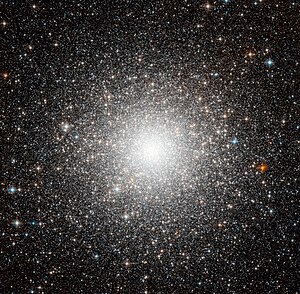| Messier 54 | |
|---|---|
 M54 by Hubble Space Telescope; 3.4′ view | |
| Observation data (J2000 epoch) | |
| Class | III[1] |
| Constellation | Sagittarius |
| Right ascension | 18h 55m 03.33s[2] |
| Declination | −30° 28′ 47.5″[2] |
| Distance | 87.4 kly (26.8 kpc)[3] |
| Apparent magnitude (V) | 7.6[4] |
| Apparent dimensions (V) | 12.0′ |
| Physical characteristics | |
| Radius | 153 ly[5] |
| Estimated age | 13 Gyr[6] |
| Notable features | Probably extragalactic |
| Other designations | M54,[7] NGC 6715,[7] GCl 104,[7] C 1851-305[7] |
Messier 54 (also known as M54 or NGC 6715) is a globular cluster in the constellation Sagittarius.[a] It was discovered by Charles Messier in 1778 and then included in his catalog of comet-like objects.
It is easily found in the sky, being close to the star ζ Sagittarii. It is, however, not resolvable into individual stars even with larger amateur telescopes.
In July 2009, a team of astronomers reported that they had found evidence of an intermediate-mass black hole in the core of M54.[8]
- ^ Cite error: The named reference
hcob849_11was invoked but never defined (see the help page). - ^ a b Cite error: The named reference
aj140_6_1830was invoked but never defined (see the help page). - ^ Cite error: The named reference
ramsay_wu_2005was invoked but never defined (see the help page). - ^ "Messier 54". SEDS Messier Catalog. Retrieved 29 April 2022.
- ^ From trigonometry: radius = distance × sin( diameter_angle / 2 ) = 153 ly.
- ^ Geisler, Doug; Wallerstein, George; Smith, Verne V.; Casetti-Dinescu, Dana I. (2007). "Chemical Abundances and Kinematics in Globular Clusters and Local Group Dwarf Galaxies and Their Implications for Formation Theories of the Galactic Halo". Publications of the Astronomical Society of the Pacific. 119 (859): 939–961. arXiv:0708.0570. Bibcode:2007PASP..119..939G. doi:10.1086/521990. S2CID 119599242.
- ^ a b c d Cite error: The named reference
simbadwas invoked but never defined (see the help page). - ^ Ibata, R.; Bellazzini, M.; Chapman, S. C.; Dalessandro, E.; et al. (2009). "Density and Kinematic Cusps in M54 at the Heart of the Sagittarius Dwarf Galaxy: Evidence for a 104 M☉ Black Hole?". Astrophysical Journal Letters. 699 (2): L169–L173. arXiv:0906.4894. Bibcode:2009ApJ...699L.169I. doi:10.1088/0004-637X/699/2/L169. S2CID 15976588.
Cite error: There are <ref group=lower-alpha> tags or {{efn}} templates on this page, but the references will not show without a {{reflist|group=lower-alpha}} template or {{notelist}} template (see the help page).